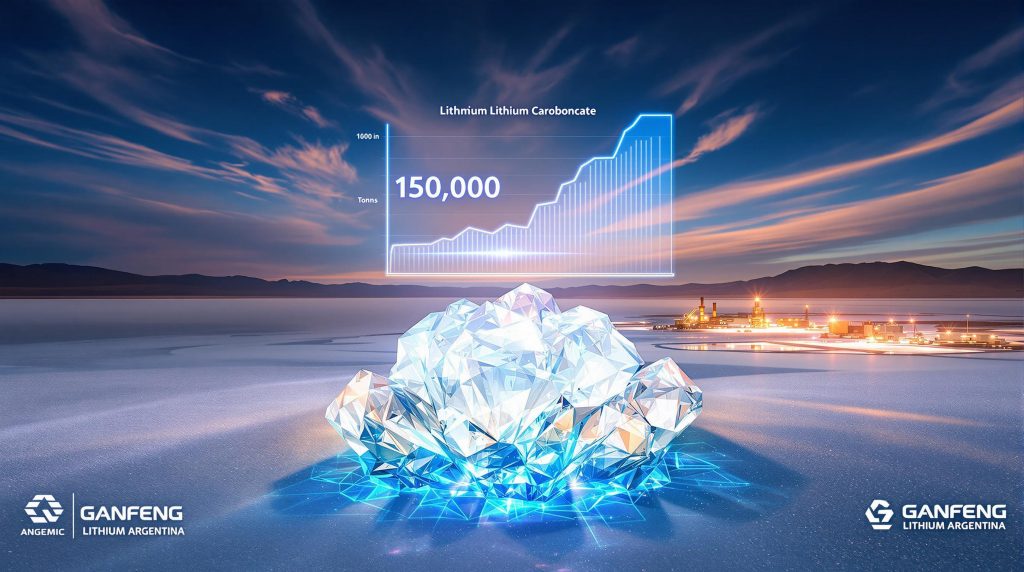Lithium Argentina and Ganfeng's Strategic Partnership: Reshaping the Lithium Landscape in Salta
In a landmark development for Argentina's lithium industry, Lithium Argentina and Ganfeng Lithium Group have announced a framework agreement to combine their respective lithium projects in Argentina's Salta province. This strategic merger is set to create one of the largest lithium operations in South America's renowned "Lithium Triangle," potentially transforming the global supply chain for this critical battery metal.
The Strategic Framework and Structure
The new joint venture will combine Lithium Argentina's Pastos Grandes and Sal de la Puna projects with Ganfeng's Pozuelos-Pastos Grandes asset, creating an integrated operation known as "PPG." According to the agreement, Ganfeng will hold the majority stake at 67%, while Lithium Argentina will maintain a 33% interest. These ownership percentages were determined based on resource contributions, capital investments, and technological inputs from both parties.
"This transaction builds on our successful partnership with Ganfeng at Cauchari-Olaroz, Argentina's largest lithium operation," said Sam Pigott, CEO of Lithium Argentina. "With this transformative step forward, we are increasing our ownership into the Pozuelos basin and aligning our interests around a substantially larger-scale operation."
The transaction is expected to close by the first quarter of 2026, pending various regulatory approvals and standard closing conditions. The timeline reflects the complex nature of combining these substantial assets and securing necessary permissions from Argentine authorities.
Production Ambitions and Technological Innovation
The merged operation is targeting an impressive production capacity of up to 150,000 tonnes per year of lithium carbonate equivalent (LCE). This ambitious goal would position the joint venture as one of the most significant lithium producers globally, substantially contributing to the supply of this critical battery material.
What sets this project apart technologically is its planned hybrid production approach. The operation will combine direct lithium extraction benefits with traditional solar evaporation methods—a strategy that could potentially offer the benefits of both approaches while mitigating their individual limitations.
DLE technologies have gained significant attention in recent years for their potential to accelerate production timelines and reduce environmental footprints compared to conventional evaporation ponds. By implementing this hybrid approach, the joint venture aims to optimize recovery rates while maintaining cost efficiency.
A comprehensive feasibility study for the integrated project is expected by the end of 2025, which will provide more detailed insights into production methods, timelines, and economic projections. Following this study, the companies plan to apply for Argentina's Incentive Regime for Large Investments in the first half of 2026, a program designed to attract and support major capital projects in the country.
Capital Structure and Financial Arrangements
The financial foundation of this merger reflects significant prior investment and new capital commitments. Approximately $1.8 billion has already been invested across the combined assets to date, demonstrating both companies' substantial commitment to developing these resources.
As part of the transaction, Ganfeng will provide Lithium Argentina with a $130 million debt facility. This financing package comes with a six-year term and carries an interest rate based on the Secured Overnight Financing Rate (SOFR) plus 2.5%. The funds will serve dual purposes: refinancing Lithium Argentina's existing corporate debt and funding ongoing development activities.
The loan is secured by Lithium Argentina's equity stake in the PPG joint venture, aligning the financing structure with the overall partnership arrangement. This financial support underscores Ganfeng's confidence in the project and provides Lithium Argentina with improved balance sheet flexibility during the development phase.
Strategic Offtake Agreements
The framework agreement includes provisions for product offtake, giving Ganfeng rights to purchase up to 50% of Lithium Argentina's production share from the initial development phase. This arrangement is capped at a maximum volume of 6,000 tonnes per year, ensuring Lithium Argentina retains meaningful market exposure.
Importantly, the pricing mechanism for these offtake agreements will be based on market rates, allowing both parties to benefit from potential upward price movements in the lithium industry innovations while providing certainty regarding product placement.
Strategic Significance for the Global Lithium Supply Chain
Consolidating Resources in the Lithium Triangle
The merger represents a significant consolidation of lithium resources within Argentina's portion of the "Lithium Triangle"—a region spanning parts of Argentina, Bolivia, and Chile that contains approximately 58% of the world's lithium resources. By bringing together previously fragmented assets in Salta province, the joint venture creates opportunities for more efficient extraction and economies of scale.
This consolidated approach allows for optimized basin management, potentially increasing recoverable resources while reducing the environmental footprint per tonne of lithium produced. The integration of adjacent properties also creates opportunities for shared infrastructure, reducing capital requirements and accelerating development timelines.
The combined expertise of both companies represents another strategic advantage. Ganfeng brings substantial technical expertise in lithium processing and battery material production, while Lithium Argentina contributes deep regional experience and established relationships with local stakeholders and regulatory authorities.
Market Impact and Supply Chain Implications
When fully operational, the PPG joint venture could significantly impact global lithium supply dynamics. The planned production capacity of up to 150,000 tonnes per year represents a substantial addition to worldwide lithium supply, potentially influencing market pricing and availability.
For battery manufacturers and electric vehicle producers, this development represents a potential new source of supply security, coming at a time when demand projections for lithium continue to rise alongside electric vehicle adoption rates and energy storage deployment.
The partnership also reflects the ongoing trend of consolidation in the global lithium industry, as companies seek to achieve the scale necessary to meet growing demand efficiently. This consolidation trend has accelerated in recent years as the strategic importance of critical minerals energy transition has been increasingly recognized by both corporate and government entities.
Building on Established Collaboration
Extending a Proven Partnership Model
The PPG joint venture builds upon the existing partnership between Lithium Argentina and Ganfeng at the Cauchari-Olaroz operation, which is described as Argentina's largest lithium operation. This prior collaboration provides a foundation of trust and established working relationships that should benefit the new venture.
The success of their previous joint efforts suggests the companies have developed effective mechanisms for knowledge sharing, decision-making, and operational management—critical factors for the success of international partnerships in complex resource development projects.
By increasing Lithium Argentina's ownership in the Pozuelos basin through this transaction, the company gains greater exposure to a lithium-rich area while benefiting from shared development costs and Ganfeng's technical expertise. This balanced approach allows Lithium Argentina to maintain significant project interest while managing development risk.
Balancing Global Interests
The partnership structure reflects a pragmatic balancing of interests between Western and Chinese lithium companies. For Lithium Argentina, the joint venture provides access to Ganfeng's processing expertise and financial resources while maintaining a meaningful ownership position. For Ganfeng, the arrangement strengthens its position as a leading global lithium supplier with access to premium South American brine resources.
This collaborative model may serve as a template for future international partnerships in critical mineral development, particularly in regions where combining Western capital markets access with Chinese technical expertise and offtake capabilities creates mutual advantages.
The knowledge transfer opportunities between partners could accelerate technological advancement and operational improvements, potentially benefiting both companies beyond this specific project. As the Argentina lithium brine insights continue to evolve rapidly, such cross-border collaboration may become increasingly important for successful project development.
Technical Innovations Driving Development
Advanced Extraction Technologies
The hybrid approach combining traditional solar evaporation with direct lithium extraction (DLE) represents an innovative technical strategy that could deliver significant advantages. Traditional solar evaporation has been the standard method for lithium brine processing in the region for decades, but it typically requires 18-24 months to concentrate lithium through natural evaporation.
DLE technologies, which use various selective adsorption or ion exchange processes, potentially offer much faster extraction timelines—sometimes reducing processing time to days or weeks rather than years. However, DLE generally requires more energy and has higher operational costs than traditional methods.
By combining these approaches, the joint venture aims to optimize the balance between speed, cost, and recovery rates. The hybrid model could allow for initial concentration through solar evaporation, followed by DLE processing to accelerate final production and increase overall lithium recovery rates.
This approach could also reduce the environmental footprint compared to conventional brine operations, particularly regarding water usage and land disturbance. The selective nature of DLE technologies typically results in fewer impurities in the final product, potentially simplifying downstream processing requirements.
Operational Synergies and Efficiencies
The geographical proximity of the combined assets creates significant opportunities for operational synergies. Consolidated resource management across adjacent lithium-rich basins allows for optimized extraction planning and coordinated water management strategies—a critical consideration in the arid Puna region of Argentina.
Shared infrastructure development, including processing facilities, transportation networks, and utility connections, could substantially reduce capital requirements compared to developing separate operations. This efficiency could improve overall project economics and accelerate the timeline to commercial production.
The unified approach also streamlines environmental monitoring systems and community engagement efforts, creating more consistent and comprehensive programs across the combined property package. This coordinated approach is increasingly important as stakeholder expectations regarding environmental and social performance continue to rise.
Investment Implications and Shareholder Value
Strengthening Financial Foundations
For Lithium Argentina, the transaction brings significant financial benefits beyond the project's potential future cash flows. The $130 million debt facility from Ganfeng provides immediate balance sheet improvement through refinancing existing corporate debt, likely at more favorable terms.
The shared development costs reduce Lithium Argentina's capital requirements while maintaining significant exposure to the project's upside potential. This capital-efficient approach allows the company to participate in a world-class lithium development without taking on disproportionate financial risk.
The partnership with an established global producer like Ganfeng reduces overall development risk through access to proven technical expertise and established marketing channels. This de-risking effect could potentially lead to a lower cost of capital for future financing needs.
"This partnership represents a significant milestone in the evolution of Argentina's lithium sector," said Wang Xiaoshen, Vice Chairman of Ganfeng, in a statement released by the company. "By combining our resources and expertise, we create a platform for sustainable growth that benefits all stakeholders."
Long-term Strategic Positioning
The PPG joint venture secures Lithium Argentina's role in large-scale lithium production for decades to come. The substantial resource base and planned production capacity establish the company as a significant player in the global lithium supply chain, rather than just a project developer.
The partnership creates a platform for sustainable growth in Argentina's lithium sector, potentially leading to additional opportunities as the companies develop deeper operational expertise and stakeholder relationships in the region. This established presence could provide advantages in securing future lithium resources or expansion opportunities.
By diversifying operational risk while maintaining significant upside potential, the structure balances near-term certainty with long-term growth potential. This balanced approach is particularly valuable in the battery metals investment landscape, where market conditions can be volatile and project development timelines often extend over many years.
Implementation Challenges and Considerations
Navigating Regulatory Processes
Securing approval under Argentina's Incentive Regime for Large Investments represents a significant regulatory milestone for the project. This program offers potential tax benefits and regulatory certainty but requires comprehensive applications and government approval.
The project will need to navigate provincial and federal permitting requirements, including environmental impact assessments, water usage authorizations, and community consultation processes. Argentina's federal structure means both national and provincial authorities have jurisdiction over different aspects of mining projects.
Potential changes in Argentina's mining regulations create some regulatory uncertainty, particularly given the country's history of policy shifts following election cycles. The companies will need to maintain close engagement with regulatory authorities at all levels to navigate this complex landscape effectively.
As scrutiny of foreign investment in strategic resources increases globally, the joint venture may face additional review processes, particularly given the majority ownership by a Chinese company. Proactive engagement with relevant stakeholders will be essential to address potential concerns.
Technical and Operational Considerations
Successfully integrating different extraction technologies presents technical challenges that will require careful planning and testing. The hybrid DLE and evaporation approach is innovative but will need to be optimized for the specific brine chemistry of the Salta basins.
Water management remains a critical consideration in the arid Puna region. The operation will need to implement sophisticated water recycling and conservation measures to minimize consumption and potential impacts on local communities and ecosystems.
Optimizing production processes for maximum efficiency while meeting stringent quality requirements will be essential for project economics. The specific grade, impurity profile, and consistency of the lithium product will significantly impact marketability and pricing.
Building local technical capacity and workforce development programs will be necessary to support the operation over its multi-decade lifespan. Establishing training programs and career pathways for local community members represents both a challenge and an opportunity for creating shared value.
Key Questions About the Lithium Argentina-Ganfeng Joint Venture
What is the combined production target for the new joint venture?
The merged operation aims to produce up to 150,000 tonnes per year of lithium carbonate equivalent (LCE), positioning it as one of the largest lithium brine operations in Argentina and a significant contributor to global supply.
When is the deal expected to close?
The companies anticipate finalizing the transaction by the first quarter of 2026, subject to regulatory approvals and customary closing conditions. This timeline reflects the complex nature of the transaction and regulatory processes involved.
How will the production technology differ from traditional lithium operations?
The joint venture will implement a hybrid approach combining direct lithium extraction (DLE) technology with conventional solar evaporation methods. This combined approach aims to improve efficiency, potentially reduce environmental impacts, and accelerate production timelines compared to traditional evaporation-only operations.
What financial support is Ganfeng providing to Lithium Argentina?
Ganfeng will extend a six-year $130 million debt facility to Lithium Argentina at SOFR plus 2.5%, secured by Lithium Argentina's equity in the joint venture. This financing will be used to refinance corporate debt and fund development activities, strengthening Lithium Argentina's financial position.
How does this agreement affect lithium offtake arrangements?
Ganfeng will have rights to purchase up to 50% of Lithium Argentina's production share from the initial development phase, with a maximum volume of 6,000 tonnes per year. These offtake arrangements will use market-based pricing mechanisms, balancing supply security with market exposure.
Future Outlook for the Salta Lithium Partnership
The Lithium Argentina-Ganfeng merger represents a significant development in Argentina's evolving lithium sector. By combining complementary assets and expertise, the joint venture creates a potentially world-class operation with substantial production capacity and technological advantages.
The success of this partnership could establish a template for future collaborations between Western and Asian companies in strategic mineral development. The balanced approach to ownership, financing, and offtake arrangements demonstrates how international partnerships can address the capital-intensive nature of large-scale lithium development.
As the global transition to electric vehicles and renewable energy storage accelerates, securing sustainable and responsible lithium supply chains becomes increasingly critical. The PPG joint venture positions both companies to play significant roles in meeting this growing demand while potentially delivering substantial returns to shareholders and benefits to local communities.
Disclaimer: This article contains forward-looking statements about project development, production targets, and market conditions. Actual outcomes may differ from projections due to various factors including regulatory approvals, technical challenges, market fluctuations, and other risks inherent in resource development. Readers should not rely solely on this information for investment decisions and should conduct their own due diligence.
Looking to Capitalise on Major Mineral Discoveries?
Stay ahead of the market with Discovery Alert's proprietary Discovery IQ model, which provides instant notifications when significant ASX mineral discoveries are announced, turning complex data into actionable investment insights. Explore how historic discoveries have generated substantial returns by visiting Discovery Alert's dedicated discoveries page.




